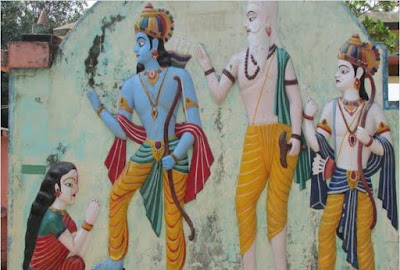ॐ प्रातरग्निं प्रातरिन्द्रं हवामहे प्रातर्मित्रा वरुणा प्रातरश्विना ।
प्रातर्भगं पूषणं ब्रह्मणस्पतिं प्रातस्सोममुत रुद्रँ हुवेम ॥
Aum praataragniṃ praatarindraṃ havaamahe praatarmitraa varuṇaa praatarashvinaa |
praatarbhagaṃ pooṣhaṇaṃ brahmaṇaspatiṃ praatass somamuta rudraṃ huvem ||
At dawn, we invoke Agni (the fire deity), Indra (the rain deity), Mitrā (the Sun) and Varuṇa (the deity of the ocean); the Aśvins (the celestial physician twins), Bhaga (the deity of wealth), Puṣan (the Sun as the deity of nutrition), Bṛahmaṇaspati (the preceptor of the gods), Soma (the Moon), and Rudra (the god of dissolution)
हम प्रात: के समय पर अग्नि, वरुण, इन्द्र, मित्र, अश्विन कुमार, भग, पूष, ब्रह्मनास्पति, सोम और रूद्र का आवाहन करते हैं
प्रातर्जितं भगमुग्रँ हुवेम वयं पुत्रमदितेर्यो विधर्ता ।
आद्ध्रश्चिद्यं मन्यमानस्तुरश्चिद्राजा चिद्यंभगं भक्षीत्याह॥
Praatarjitaṃ bhagmugraṃ huvem vayaṃ putramaditeryo vidhartaa |
aadhrash chidyaṃ manya maanastu rashchidraajaa chid yaṃ bhagaṃ bhakṣhityaaha ||
We invoke at dawn, the fierce Bhaga, the son (manifestation) of Aditi (the Cosmic Power), who is the very sustainer of the creation. Whether a pauper, a busy person, or a king; everyone worships and contemplates upon Bhaga saying, 'I would worship Bhaga.'
हम शक्तिशाली, युद्ध में जीतने वाले भग का आवाहन करते हैं जिनके बारे में सोचकर राजा भी कहते हैं की हमें भग दीजिए
भग प्रणेतर्भगसत्यराधो भगेमां धियमुदवददन्नः।
भगप्रणो जनय गोभि-रश्वैर्भगप्रनृभि-र्नृवन्तस्स्याम ॥
bhagha praṇetarbhaga satyaraadho bhaghemaaṃ dhiyamudava dadannaḥ |
bhaga praṇo janaya gobhirashvairbhaga pranṛibhirnṛivantassyaam ||
O Bhaga! The great leader, and truth is your wealth. Bestow it upon us, and elevate our intellect and protect it. Bless us with cattle-wealth, horses, and descendants and followers.
हे भग हमारा मार्गदर्शन करें ,आपके उपहार अनुकूल हैं ,हमें ऐश्वर्य दीजिये हे भग! हमें घोडे {सवारी }, गाय और योद्धा वंशज दीजिए
उतेदानीं भगवन्तस्यामोत प्रपित्व उत मध्ये अह्नाम्।
उतोदिता मघवन् सूर्यस्य वयं देवानाँ सुमतौ स्याम ॥
utedaaneeṃ bhagavantasyaamot prapitv ut madhye ahnaam |
utoditaa maghavan sooryasya vayaṃ devaanaaṃ sumatau syaam ||
4. May we be blessed by Bhaga now (during this fire-ritual), and when the light approaches, or at midday. O Lord Indra! At sunset also, may we still find favor of the Sun, and other gods.
4. कृपा कीजिये कि अब हमें सुख-चैन मिले , और जैसे जैसे दिन बढ़ता जाये , जैसे -जैसे दोपहर हो , शाम हो हम देव कृपा से प्रसन्न रहे
भग एव भगवाँअस्तु देवास्तेन वयं भगवन्तस्स्याम।
तं त्वा भग सर्व इज्जोहवीमि सनो भग पुर एता भवेह॥
bhaga eva bhagavaanastu devaastena vayaṃ bhagvantasyaam |
taṃ tvaa bhaga sarva ijjohaveemi sano bhaga pur etaa bhaveha ||
5. May Bhaga, (and) the gods be the possessor of good fortune, and through Him, may we may be blessed with good fortune by that god. Everyone including myself invite you to bring in good fortune. O Bhaga! Kindly lead us being present in the ritual.
5. हे भग आप परमानंद प्रदान करें और आपके द्वारा देव हमें प्रसन्नता से स्वीकार करें हे भग हम आपका आवाहन करते हैं ,आप यहाँ हमारे साथ आयें
समध्वरायोषसोऽनमन्त दधिक्रावेव शुचये पदाय।
अर्वाचीनं वसुविदं भगन्नो रथमिवाश्वावाजिन आवहन्तु॥
samadhvaraayoshaso namanta dadhikraaveva shuchaye padaaya |
arvaacheenaṃ vasuvidaṃ bhaganno rathamivaaśhvaa vaajina aavahantu ||
6. May the presiding deities of the early morning-hour arrive here, like the horse that puts its foot in the place of Vedic ritual for establishing the fire altar. May they bring Bhaga, the Lord of wealth, as speedily as swift horses pulling a chariot
6. इस प्रकार प्रतिदिन भग यहाँ आयें {पवित्र स्थान जैसे दधिक्रावन }जैसे शक्तिशाली घोड़े रथ को खींचते हैं वैसे ही भग का यहाँ आवाहन किया जाये
अश्वावतीर्गोमतीर्नउषासो वीरवतीस्सदमुच्छन्तु भद्राः।
घृतं दुहाना विश्वतः प्रपीनायूयं पात स्वस्तिभिस्सदा नः॥
ashhvaavateergomateerna uṣhaaso veeravateess sadamuchchantu bhadraḥ |
ghṛitaṃ duhanaa vishvataḥ prapeenaa yūyaṃ paata swastibhissadaa naha||
May the presiding deities of the Dawn bless us with many horses and cattle, and plenty of milk and milk-products. May these auspicious gods bless us with good progeny, and nourish all life. May they proclaim auspiciousness in the place of worship. May they always ensure our good fortune
इस प्रकार कृतार्थ सुबह हमें प्राप्त हो हमें हमें सुपुत्र, घोडे, पशु, दुग्ध और योधा रिश्तेदार प्राप्त हो हे देव हमें अपने आशीर्वाद दीजिये
ॐ अवैध मृत्युम न अमृतम न आगम मैव सुतो नो अभै त्रुणोत ।
वर्णम वनस्पती रिभाभिनष्यी यथागम भयै सदा नस्च जिपदही ।।
परम प्रत्यो अन्पढे एवम धयस्ते श्वेतयो देवाय न आत ।
तत्क्षुस्मते ब्रह्मणे देव प्रवी विमानव प्रजा ग्म्य निसोमोद विनोद्: ।।
वातम प्राणम वन्सान्त्वा हावामहे प्रजापतिम्यो भुवन्श्य गोप: ।
स नो रुद्रो: स्त्राय धान्त्वाम त्रध्युम धधयो जीवा: धधा मुचिमहे ।।
अमृत प्रभु या धध: योग्यवस्य वृहश्पते अभिशस्त्रे न रुद्र: ।
मृत्यो हावा मश्मिना मृत्यो मस्मा देवानामने भि च गाच देवहि: ।।
परिगम धनम च मुचयम च देवा विश्वा शेषानम पृतभम पतीनअ्म ।
ब्रह्मा सदो च वेदमागा च यधमागा मधिय विक्रमस्य: ।।
सल्के न अग्निम दानभुतौ लोकौ स नै माहम ।
उपायो भोगयो रुध्रापी मृत्युम जराम्य्हम ।।
मा चिदो मृत्यो मा वधेर मा मे बलम चिदहो मा प्रमोसि: ।
प्रजाम मा मे रीरिष: समायु रुद्र निरक्ष सन्त्रा: हविषा विधेमा ।।
मा नो महान्त मुत मानो अर्ब्भकम्मन अक्ष्यन्त मुत मान उक्षितम ।
मा नो व्यधिम पितरम्मोत मातरम्मनम प्रियास्तनवो रुद्ररीरिष: ।।
मानस्तोके तनए मान आयौ मानो अश्वेषु रीरिश: ।
वीरन्मानो रुद्र भामितो वेधी: हविष्मन्त सदमित्वा हावामहे ।।
इस वैदिक सूक्त का पाठ कोई भी कर सकता है इसका पाठ करने से या इसे सुनना सौभाग्याकारी है
ऋग्वेद ७-४१














